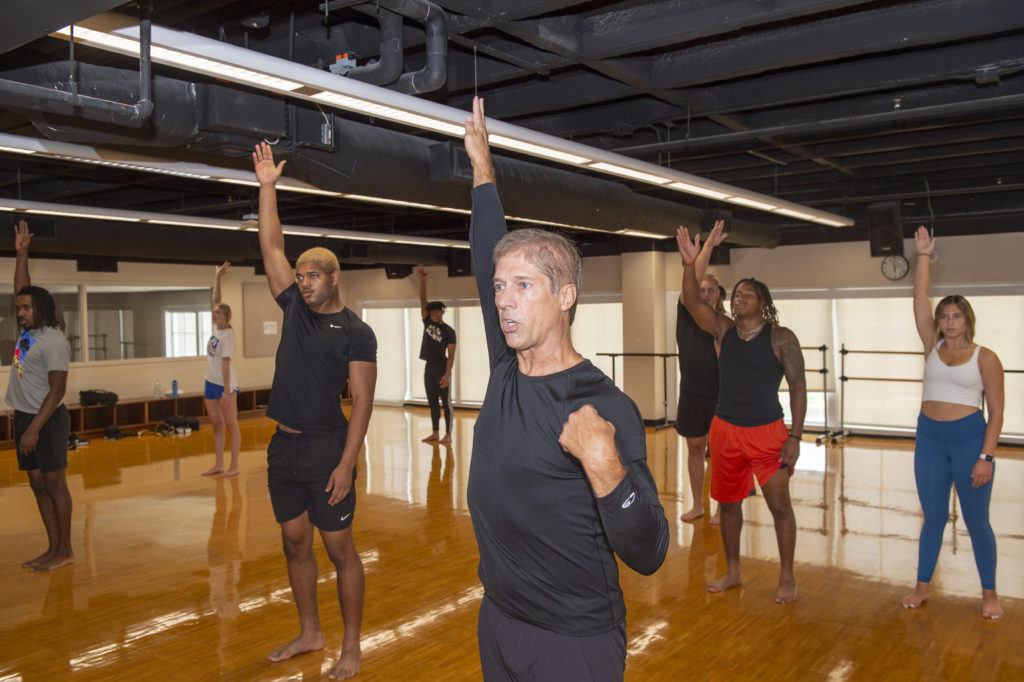
As a rule, dancers tend to be a close-knit, insular bunch—and that inclination reaches new extremes in many a college dance program. There, dancers are often content to dance, study, eat and even live with fellow members of their BFA cohort.
So if you’re a professor teaching classes open to students both within and outside the dance major, creating a singular and welcoming classroom community can feel like an uphill battle. To help you foster relationships among all of your students this fall, Dance Teacher enlisted the advice of three professors who are each familiar with this challenge.

Setting the Stage
Any professor trying to make non-BFA dancers feel truly included will first want to consider whether the learning environment is set up for success. Christopher Dolder, associate professor and chair of dance at Southern Methodist University, sees the classic dilemma of mixing up dance degree programs as this: “BAs and BFAs take class together, and someone feels inferior or like there’s a caste system.” If the BFA contingent consistently goes first across the floor and fills up the front of the studio, that implies a hierarchy of student types that may be hard to break. Robert Cook, assistant professor of dance at Hofstra University, says that you can and should disrupt these natural patterns of who’s where in the studio: “I’ll bring the students who are challenged the most by the class to the front, because they can see more there,” he says.
Cook’s advice holds whether it’s a technique class in a studio or a theory course in a classroom. In any environment, you’ll want to physically mix up dancers of different degree programs, concentrations and minors throughout the room.
Correcting Your Corrections
So how can a BA student or dance minor compete in technical prowess with a BFA who’s dancing many more hours a week? In your classes, they should know that professors aren’t comparing “types” of students. “I’m very in touch with my students about there being no single way to approach learning goals and grading for everyone,” says Meg Paul, director of dance for Wayne State University’s Maggie Allesee Department of Theatre and Dance.
Paul advises keeping your grading criteria, learning outcomes and learning goals crystal-clear and encourages students to focus on individual growth and personal effort. Cook, for his part, suggests distributing both praise and corrections mindfully and fairly among majors and nonmajors: “Point out students who are doing things in an interesting way, but don’t make any star dancer the example.” These two strategies in tandem will help alleviate any fears that BFA candidates are getting preferential consideration from professors like you.

Let Dancers Lead
The more unevenly your attention is distributed among students, the more likely it is that dancers’ knowledge and approaches will get lost in the shuffle. Break this pattern by elevating student perspectives, and you’ll also be highlighting the unique value every dancer brings to the learning environment. As Dolder says, “Our job is to create artists with a clear point of view who are very understanding of their powers of expression.” Ask more open-ended and subjective questions of dancers. Encourage interdisciplinary thinking that values perspectives beyond those of lifelong dance-world insiders.
One more way to give all dancers more agency is to open up departmental resources to a wider constituency—and encourage professors to communicate with all students. Paul has had Bachelor of Science in Dance advisees come during office hours, asking if they could take upper-level choreography courses. “If students come and communicate with us, nine times out of 10 we are able to solve the issue,” Paul says, “and in all cases they feel heard and have a greater understanding.” If certain courses in your department are strictly or just informally reserved for the BFA track, it might be worth reexamining these policies so that they benefit everyone. And even if student advisory boards, performance opportunities and guest-artist master classes are in fact open to students not majoring in dance, make sure those dancers know about such opportunities—and feel truly welcome and encouraged to take advantage of them.
Safe for All to Take Risks
Perhaps more than any other strategy, making your classroom failure-friendly will encourage all dancers to feel empowered in their own dance education. When Dolder teaches dance to students outside of the major, he finds that one of the biggest and most consistent obstacles to learning is students’ feelings of self-consciousness. Start by acknowledging this sense of awkwardness, and then challenge everyone to transcend their own paradigms of dance knowledge or mastery. “I don’t allow anybody to castigate, denigrate, snicker or laugh at anyone in the class,” Dolder says. Support students in starting to question ingrained beliefs about how a “real” dancer moves, or what that dancer looks like, or what their prior training should consist of.
As far as a completely level playing field is concerned, “I don’t know if there’s a perfect scenario,” Paul says. “We’re constantly auditing ourselves on language—even looking at language like ‘non-BFA’ and ‘nonmajors’—and proximity and accessibility. But it’s worthwhile energy spent to make sure we’re creating spaces and opportunities for everyone to feel part of dance on campus.”




